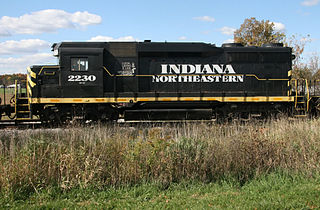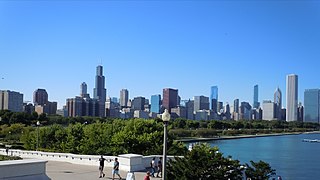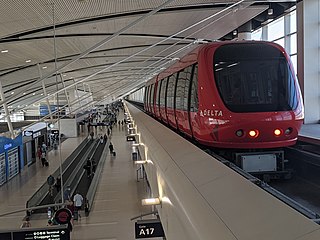
The New York Central Railroad was a railroad primarily operating in the Great Lakes and Mid-Atlantic regions of the United States. The railroad primarily connected greater New York and Boston in the east with Chicago and St. Louis in the Midwest, along with the intermediate cities of Albany, Buffalo, Cleveland, Cincinnati, Detroit, Rochester and Syracuse. New York Central was headquartered in New York City's New York Central Building, adjacent to its largest station, Grand Central Terminal.
The Lake Shore and Michigan Southern Railway, established in 1833, and sometimes referred to as the Lake Shore, was a major part of the New York Central Railroad's Water Level Route from Buffalo, New York, to Chicago, Illinois, primarily along the south shore of Lake Erie and across northern Indiana. The line's trackage remains a major rail transportation corridor used by Amtrak passenger trains and several freight lines; in 1998, its ownership was split at Cleveland, Ohio, between CSX Transportation to the east and Norfolk Southern Railway in the west.

The Grand Trunk Western Railroad Company was an American subsidiary of the Grand Trunk Railway, later of the Canadian National Railway operating in Michigan, Illinois, Indiana, and Ohio. Since a corporate restructuring in 1971, the railroad has been under CN's subsidiary holding company, the Grand Trunk Corporation. Grand Trunk Western's routes are part of CN's Michigan Division. Its primary mainline between Chicago and Port Huron, Michigan serves as a connection between railroad interchanges in Chicago and rail lines in eastern Canada and the Northeastern United States. The railroad's extensive trackage in Detroit and across southern Michigan has made it an essential link for the automotive industry as a hauler of parts and automobiles from manufacturing plants.

Michigan Services are three Amtrak passenger rail routes connecting Chicago, Illinois with the Michigan cities of Grand Rapids, Port Huron, and Pontiac, and stations en route. The group falls under the Amtrak Midwest brand and is a component of the Midwest Regional Rail Initiative.

The Michigan Central Railroad was originally chartered in 1832 to establish rail service between Detroit, Michigan, and St. Joseph, Michigan. The railroad later operated in the states of Michigan, Indiana, and Illinois in the United States and the province of Ontario in Canada. After about 1867 the railroad was controlled by the New York Central Railroad, which later became part of Penn Central and then Conrail. After the 1998 Conrail breakup, Norfolk Southern Railway now owns much of the former Michigan Central trackage.
The Chicago and Canada Southern Railway was a planned extension of the Canada Southern Railway west from Grosse Ile, Michigan to Chicago, Illinois. The line was only built to Fayette, Ohio, and was later split between the Detroit, Toledo and Ironton Railway and Lake Shore and Michigan Southern Railway.

The Wolverine is a higher-speed passenger train service operated by Amtrak as part of its Michigan Services. The 304-mile (489 km) line provides three daily round-trips between Chicago and Pontiac, Michigan, via Ann Arbor and Detroit. It carries a heritage train name descended from the New York Central Railroad.

The Indiana Northeastern Railroad is a Class III short line freight railroad operating on nearly 130 miles (210 km) in southern lower Michigan, northeast Indiana and northwest Ohio. The Indiana Northeastern Railroad Company began operations in December 1992 and is an independent privately owned company. As of 2017 the railroad hauled more than 7,000 carloads per year. Commodities moved by the railroad include corn, soybeans, wheat and flour. It also handles plastics, fiberboard, aluminum, copper, coal, perlite, stone, lumber, glass, rendering products, as well as agricultural fertilizers and chemicals.

The Chicago, Kalamazoo and Saginaw Railway (CK&S), known informally as the "Cuss, Kick & Swear" is a defunct railroad which operated in southwest Michigan in the late 19th and early to mid 20th centuries. Despite the name, the line ran entirely within the state of Michigan, with the majority in Kalamazoo County. It eventually became part of the New York Central. As of 2010, most of the former CK&S tracks have since been abandoned.
Michigan United Railways (MUR) was an interurban which owned and leased numerous lines in the state of Michigan during the early twentieth century.

The Great Lakes megalopolis consists of a bi-national group of metropolitan areas in North America largely in the Great Lakes region. It extends from the Midwestern United States in the south and west to western Pennsylvania and Western New York in the east and northward through Southern Ontario into southwestern Quebec in Canada. It is the most populated and largest megalopolis in North America.

The Lake Cities was a daily passenger train operated by Amtrak between Chicago, Illinois and Toledo, Ohio via Detroit, Michigan. It operated from 1980 until 2004, when it was folded into the Wolverine. It replaced the St. Clair, a Chicago–Detroit train which operated in tandem with the Wolverine. The extension to Toledo gave travelers in Michigan the opportunity to connect with eastbound trains such as the Lake Shore Limited without backtracking to Chicago. Amtrak re-routed the train from Toledo to Pontiac, Michigan in 1995.

Transportation in metropolitan Detroit comprises an expansive system of roadways, multiple public transit systems, a major international airport, freight railroads, and ports. Located on the Detroit River along the Great Lakes Waterway, Detroit is a significant city in international trade, with two land crossings to Canada. Three primary Interstate highways serve the region.

SEMTA Commuter Rail, also known as the Silver Streak, was a commuter train operated by the Southeastern Michigan Transportation Authority (SEMTA) and the Grand Trunk Western Railroad between Detroit and Pontiac, Michigan. It began in 1974 when SEMTA assumed control of the Grand Trunk's existing commuter trains over the route. SEMTA discontinued operations in 1983. Amtrak began offering intercity service between Detroit and Pontiac in 1994 as part of its Michigan Services.
The Detroit, Monroe and Toledo Railroad (DM&T) was a shortline railroad which operated in the U.S. states of Michigan and Ohio. Opened in 1856, its main line ran from Detroit, Michigan, to Toledo, Ohio. The railroad leased itself to the Michigan Southern and Northern Indiana Railroad (MS&NI) in 1856. A 1914 merger which created the New York Central Railroad led to the DM&T's consolidation into the new road, ending its existence.
The Kalamazoo and White Pigeon Railroad (K&WP) was a shortline railroad in the U.S. state of Michigan. It was incorporated in 1869 and consolidated with the New York Central Railroad in 1914. Its line ran from Kalamazoo, Michigan, to Constantine, Michigan.
The Rogers City Branch was a railway line in Presque Isle County, Michigan. It ran north from a junction with the Detroit and Mackinac Railway main line near Posen, Michigan, to Rogers City, Michigan, on the shore of Lake Huron. The Detroit and Mackinac opened the line in 1911, and it was abandoned by the Lake State Railway in 2000. A major customer on the branch was the limestone quarry in Calcite, east of Rogers City.

The main line of Ann Arbor Railroad is a partially-abandoned railway line in the states of Michigan and Ohio. It was constructed between 1874 and 1897 by the Ann Arbor Railroad and its predecessors, and constituted that company's main line. At its fullest extent it ran 292 miles (470 km) from Toledo, Ohio, on Lake Erie, to Frankfort, Michigan, on Lake Michigan. A train ferry service operated across Lake Michigan to Wisconsin. The original Ann Arbor Railroad went bankrupt in 1976, and ownership of the line is now split between the state of Michigan and two short-line railroads: the Ann Arbor Railroad and the Huron and Eastern Railway. The northern end of the line is now near Yuma, Michigan.

















